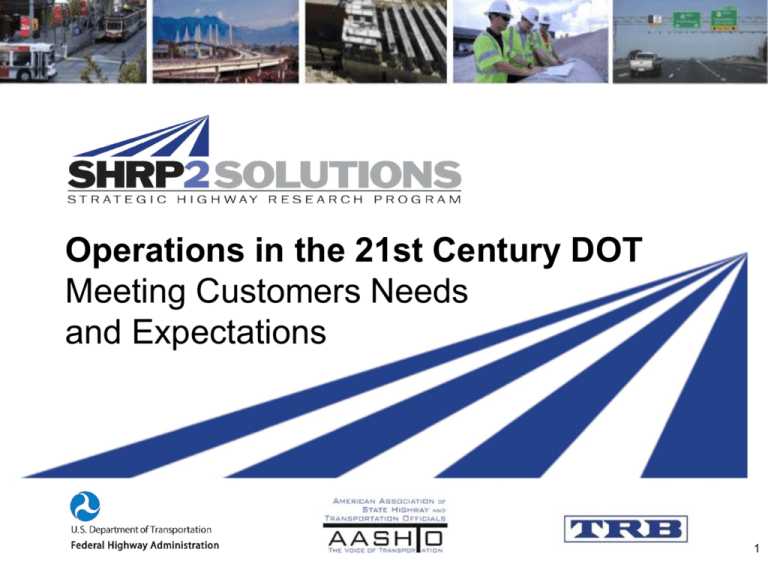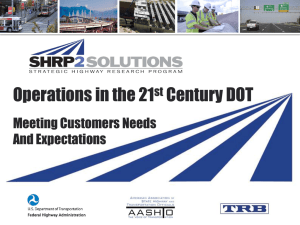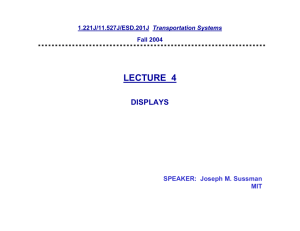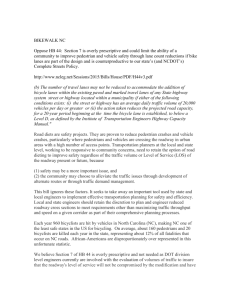PowerPoint - Strategic Highway Research Program 2
advertisement

Operations in the 21st Century DOT Meeting Customers Needs and Expectations 1 Purpose of this Meeting: Share Thoughts & Discuss • Challenges brought about by the changing transportation environment and public (i.e., “customer”) expectations • How operations and supporting technologies can help address these issues • Importance of mainstreaming operations into the DOT’s program (and the transportation planning process) 2 What is Operations? Transportation Systems Management and Operations (TSMO, TSM&O) • Defined in MAP 21 • “Integrated strategies to optimize the performance of existing infrastructure through the implementation of multimodal and intermodal, cross-jurisdictional systems, services, and projects” • Supported and enabled by Intelligent Transportation System (ITS) technologies 3 Example Operations Strategies and Solutions • Work Zone Management • Traffic Incident Management • Service Patrols • Special Event Management • Road Weather Management • Transit Management • Freight Management • • • • • • Traffic Signal Coordination Traveler Information Ramp Management Managed Lanes Active Traffic Management Integrated Corridor Management 4 The Transportation Environment is Changing • Increased reliance on information and technology • Increasing customer needs and expectations • Growing emphasis on measuring performance • Reduced financial resources • Technology also offers opportunities – multiple operations strategies and regional integration of various modes 5 Technology is Transforming Our World • Increased availability of information o Internet connectivity, wireless communications, cloud computing o Information is available 24/7 on mobile devices • Shifting customers expectations: technology can improve efficiency and service • The future – even more innovative technologies and a shorter shelf life o New data services From 511SF o Connected / autonomous vehicles website 6 Customer Expectations and Needs are Changing • Public’s expectations of government o Increased productivity and efficiency o Greater demand for accountability – value expected from the use of tax and toll dollars • Improved performance and service for commuter, freight, recreational, and other trips o Mobility, including reduced delays and congestion o Safety o Accurate, timely, and accessible information o Reliability (a focus of SHRP2 program) 7 Performance Measures Element of Increased Accountability “The game gets serious when you start to keep score!” Emphasized in MAP 21 Goals and associated measures being established for: • • • • Safety Infrastructure Condition Congestion Reduction System Reliability • Freight Movement and Economic Vitality • Environmental Sustainability • Reduced Project Delivery Delays 8 Increasing Financial Constraints Decreasing fuel tax revenues going into Trust Fund • No change in the federal gas tax since 1993 o Predictions that fund will become insolvent soon • Increased fuel efficiency o New CAFE standards o Emerging fleet of electric vehicles and plug-in hybrids pay no fuel tax MUST DO MORE WITH LESS Average Sales Weighted Miles Per Gallon 2008 - 2014 9 Operations Can Help Address These Challenges Leverage Technology • Preserve and maximize existing capacity • Enhance safety • Promote mobility and customer outreach • Improve reliability for commuters and freight • Manage bottlenecks • Monitor performance • Implement quickly at relatively low cost 10 Traditional Approach to Managing Transportation • Predict future (long-range) traffic volumes • Fund major capital projects to provide additional capacity This only addresses 40% of the congestion problem. • Also becoming more and more difficult to provide new capacity Causes of Congestion (Source: FHWA, 2005) 11 Benefits from Operations Some Specific Operations Examples 12 Work Zone Management Several strategies and technologies are available. • Traveler information & portable DMS (delays, alternate routes) • Variable speed limits • Automated speed detectors, warning signs & enforcement • Dynamic lane merge systems • Maintenance decision support Demonstrated benefits include: • Reduced crashes • Reduced work zone traffic • Reduced delays Traffic Incident Management (TIM) • Planned and coordinated process to detect, respond and clear incidents and crashes quickly and safely • Multi-disciplinary activity involving DOTs & emergency service providers • TIM reduces the duration of traffic incidents (30%-50%) o Reduces congestion o Improves reliability o Improves safety - reduces secondary crashes Safety Service Patrols and Incident Response Truck Part of TIM Program • Provides specially equipped response trucks and trained operators • Assists stranded motorists and clearing debris • Provides traffic control during traffic incidents Example Benefits • Cleared 80% of incidents within 10 minutes • Average Benefit/Cost Ratio of 12.4:1 • Favorable public response 15 Planned Special Event Management Effective event management requires agency collaboration and coordination • Planning and protocols • Day-of-event activities • Post-event activities Benefits: • Reduced delays to motorists attending (and not attending) the event • Reduced demand • Improved safety 16 Road Weather Management Reduces the impact of adverse weather conditions on travelers • Data collection • Data assimilation and analysis • Information dissemination Example Benefits • Low visibility warning system. o Crash rates during fog conditions reduced 70% – 100% • Wet pavement detection & advisory system reduced crashes by 39% • B/C ratio for automated wind advisory in Oregon = 4:1 and 22:1 Emergency Management • Large-scale impacts o Severe weather o Homeland security • Can happen anytime, often without warning • Transportation operations is critical to effective response o Whether transportation infrastructure is affected or not o Prior, during, & following event o Multi-agency planning and coordination a must Traffic Signal Synchronization Timing adjacent traffic signals to minimize stops • Can be based on time of day, traffic flows, special events Example Benefits • Reductions in traffic delay ranging from 15% - 40% • Reductions in travel time up to 25% • Very high benefit – cost ratios, sometimes exceeding 50:1 In the 2012 National Traffic Signal Report Card, operators gave themselves an overall grade of D+. Traveler Information • 511 Web and Voice • Dynamic message signs (DMS) • Radio and television traffic reports • SmartPhone apps • Social media tools • Commercial traffic conditions and prediction services Services may be provided by private sector. Example Benefits • 511 customer satisfaction of 68% - 92% • Route-specific travel times: 5% -13% increase in on-time performance (i.e., reliability) Ramp Management Metering - traffic signals on ramps to dynamically control the rate at which vehicles enter a freeway • Smoothes the flow of traffic onto the mainline Example Benefits • Metering increases freeway throughput 13% - 26% • Metering decreases crashes 15% - 43% • Greatest benefits occur when applied corridor-wide. Active Transportation and Demand Management (ATDM) Broad operational philosophy – an integrated approach for dynamically and pro-actively managing and influencing travel demand and traffic flow Uses a combination of the real-time operational strategies: • Those previously noted • Managed Lanes • Active Traffic Management • Integrated Corridor Management • Dynamic pricing Connected Vehicles and the Future • Vehicles “reading” the roadway and one another • Collisions reduced; reliability improved • Smarter operational decisions (possibly predictive) The Future? • Technology transformation changes mobility • What might be the impact of autonomous vehicles? • DOT role in supporting development Reaching Full Potential of Operations • Full potential is not primarily a “technology” issue or knowledge of best operations practices. • The key: Put in place and manage specific supportive business and technical processes and supporting institutional arrangements. “Mainstreaming Operations” Necessary at agency and regional level – Per MAP 21: State DOTs and MPOs must consider projects and strategies as part of their planning process that promote efficient operations 24 Key Leadership Questions for Mainstreaming Operations • What are your customers’ needs and expectations? • What are your current business processes for operations (e.g., who is responsible)? • Where are you today? • Where do you want and need to go? • How are you going to get there? Each DOT will have unique challenges and opportunities. 25 Mainstreaming Operations • Consider organizational issues and relationships • Focus on supporting business and technical processes within the agency • Define what constitutes an effective program • Mutual Benefits – Including operations in the Highway Safety Improvement Program, Congestion Management Process, Asset Management Plan, etc. 26 Critical Dimensions for Improved Operations in a DOT • All (6) dimensions are: o Essential o Interrelated • Require executive support and leadership • Support continuous improvement of operations and reliability Operations Capability Dimensions Business Processes • Planning and programming • Budgeting (resources) Performance • Defining measures • Data acquisition and analytics • Presentation (internal and external) Systems and Technology • Use of systems engineering • Systems architectures • Standards and interoperability 28 Operations Capability Dimensions (continued) Culture • Leadership • Outreach • Program legal authority • Technical understanding Organization / Staffing • Programmatic status • Organizational structure • Staff development and retention Collaboration Relationships and partnering: • Within DOT • Among levels of government • Public safety agencies • MPOs • Private sector 29 Levels of Capability Maturity 30 Regional Operations Collaboration “Planning for Operations” • Multi-modal collaboration between agencies and jurisdictions • Collaboration between planners and operators • Specific outcomes and regional objectives • Investments prioritized to achieve operations objectives • Demonstrated accountability through performance measures “Objectives-Driven, Performance-Based Approach” 31 Objectives-Driven, PerformanceBased Approach 32 A New Source of Information on TSM&O National Operations Center of Excellence • Partnership of AASHTO, ITE, and ITS America with support from the FHWA. • Offers a document library, peer exchanges, webinars, oncall assistance, assessments, and other TSM&O support via the Operations Technical Services Program. o A place to share information as well as receive it. • www.transportationops.org 33 Summary • Operations is a critical component for managing the transportation network on a daily basis. o Preserves and maximizes existing capacity. o Enhances mobility, reliability, safety, and environment. o Provides customer service via a performance-based approach. o Achieves quick and cost-effective implementation. • To be successful, operations needs to be “mainstreamed” into the agency's institutional and organizational framework. You have an important role to play. 34 Next Steps • Demonstrate commitment and involvement at the top level. • Empower the people who can make it happen and give them the resources they need. • Provide top-down direction and insist on bottom-up accountability. If you need assistance – Contact: • FHWA: Steve Clinger - Stephen.Clinger@dot.gov • AASHTO: Gummada Murthy - gmurthy@aashto.org 35 Questions? 36 Additional Slides as Appropriate 37 What is “Reliability”? • Consistency or dependability in travel times o As measured from day to day, or across different times of day • Less tolerance for unexpected delays • Planning for travel variability as costs for users, including individuals, transit operators, freight and their end users 38 Managed Lanes Lane(s) where use is based on: • Vehicle type / eligibility • Pricing • Access control Examples: • HOV lanes • HOT lanes • Bus-only lanes • Express toll lanes Demand and capacity managed on a pro-active basis • Price • Eligibility requirements In Minneapolis (HOV lanes converted to HOT lanes) • Peak hour corridor throughput increased 5% • No change / slight increase in speeds • General reduction in speed differentials (HOT/GP lanes) Active Traffic Management (ATM) Dynamically manage congestion based on prevailing traffic conditions • Dynamic speed displays • Dynamic lane control • Queue warning • Dynamic shoulder running Relatively new to US - European Experience • Throughput increased by 3% - 7% • Decrease in incidents by 3% - 30% • Emissions decreased 2% - 8% • Benefit / Cost ratio of 3.9 : 1 Integrated Corridor Management • Corridors offer opportunities to optimize the entire system. • ICM is the operational coordination of multiple transportation networks and cross-network links. • Integrated traveler info Example Benefits • Operational efficiency of • ICM along I-15 in San network junctions Diego: estimated B/C ratio • Cross-network route & modal of 9.7:1 shifts • Simulation of ICM: B/C ratios of 7.1:1 to 25.1:1 • Capacity and demand 41








